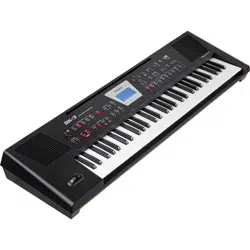Loading ...
Loading ...
Loading ...

Filtering Performance Memories Settings (Lock function)
39
If you like, you can now select another Performance memory you
want to delete, repeat from step (2).
To save your edited Performance List see “Saving the edited
Performance List” (p. 39).
Move a Performance
1.
Use the [UP] or [DOWN] button to select the Performance
memory you want to move to a dierent position inside
the list.
2. Press the [MENU] button.
3. Use the [UP] or [DOWN] button to select “Move
Performance”, then press the [ENTER] button.
The display changes to:
4. Use the [UP] or [DOWN] button to move the selected
Performance memory to the desired position, then press
the [ENTER] button.
A “*” is shown in the rst row, to the left of the Performance List
name to indicate that the list has been edited.
You can now select another Performance memory you want to
move, press the [MENU] button to conrm and repeat from step (3).
Saving the edited Performance List
Whenever the display shows all Performance memories to which
the selected List refers, you can:
1. Press the [MENU] button
2. Use the [UP] or [DOWN] button to select “Save
Performance List”, then press the [ENTER] button.
A message conrms that the data have been saved.
3. Press the [EXIT] button.
If you did not save the Performance List edited, the BK-3 now
signals that you need to save it to preserve your changes.
4. Use the [INC] or [DEC] button to select “YES” to save your
changes to the USB memory (or “NO” if you wish to keep
the previous version).
MEMO
To select “YES or “NO” you can also use the [UP] or [DOWN]
button
5. Press the [ENTER] button to conrm your selection.
Filtering Performance Memories
Settings (Lock function)
The BK-3 allows you to lock (protect) several settings to ensure that they
no longer change when you select a dierent Performance memory.
Why is it Convenient to Use Filters (Lock Function)?
The BK-3’s locks are data lters that allow you to use your
Performance memories more eciently, because you can ignore
settings that may be ne for one song (the one you prepared the
Performance memory for), but not for another.
Here is an example:
Suppose you select a Performance memory that assigns some tones
which you want to keep for the entire song (or set). In this case lock
(i.e. protect) the “Tone” after selecting this memory to ensure that
the subsequent Performance memories you recall modify all of the
BK-3’s eligible settings except for the tones.
Which Parameter Can you Filter?
Below is a list of parameters that can be ltered:
Parameter Explanation
Rhythm* Lock the Rhythm when changing performances.
Tempo* Lock the Tempo when changing performances.
Tone* Lock the Tone when changing performances.
Tone Part Lock the Tone Part when changing performances.
Split Lock the Split when changing performances.
Lower Octave Lock the Lower Octave when changing performances.
Arr Type Lock the Arr Type when changing performances.
Key* Lock the Key when changing performances.
Bass Inversion Lock the Bass Inversion when changing performances.
Scale Tune Lock the Scale Tune when changing performances.
[*] These parameters can also be switched on/o by pressing and
holding the assigned buttons on the front panel. (See “How to
Switch Filters On/O Directly by Panel”)
For information on how to lter these parameters see “Performance
Hold “ (p.51).
NOTE
Unlike the other lock parameters, the protection of the tempo
setting also applies to rhythm selection.
See [MENU] button “Performance Edit” “Arranger Setting”
“Tempo” (p. 49)
Each rhythm has a preset tempo value that is recalled when you
select it. While the tempo setting is locked, the tempo no longer
changes when you select a dierent rhythm.
MEMO
The “Save Global” parameter (p. 53) also saves the lock (and
hence the “Performance Hold”) settings.
How to Switch Filters On/O Directly by Panel
Some useful lters can be also switched on/o by pressing and
holding the assigned buttons on the front panel.
MEMO
All lters can be switched on/o by “Performance Hold “ (p.
51).
In the example shown here, you will learn how to exclude rhythm
changes from Performance selections.
The same procedure (albeit with dierent buttons) also applies to
the tempo (press and hold [TAP TEMPO]) and “Key” (press and hold
[KEY]) settings as well as to Tone selection (for each of the real-time
parts individually).
Loading ...
Loading ...
Loading ...
